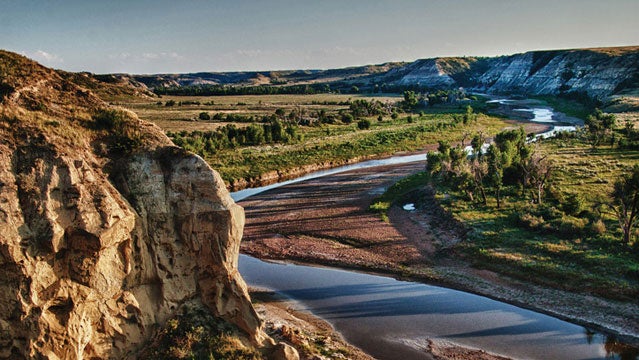National Parks, or at least the more remote parks or regions within, are sanctuaries from development. But National Parks are not walled gardens, and in some, reminders of the nation’s current surge toward energy independence can be increasingly seen, heard, smelt, and even .
That is what compelled the National Parks Conservation Association, a National Parks watchdog group, to write a that the hydraulic fracturing (or fracking) boom and conventional energy development are having on ten different National Parks across the country.
Chief among these is the Theodore Roosevelt National Park, a lesser-known park nestled in the badlands of North Dakota. It has traditionally been known for its dark skies that attract stargazers. But now, thanks to fracking activity right outside the park, “It looks like Blade Runner out there, with gas flares going off and trucks rolling by,” says James Nations, who leads the NPCA’s Center for Park Research and edited the report.
The gas flares and lights around drilling rigs have polluted the night sky across the 70,000-acre park, which is comprised of three parcels spread around the massive, 128 million-acre Bakken formation. That says nothing about concerns over what the chemical-heavy fracking fluid might be doing to water sources and what the noise and road-building from drilling operations around the park is doing to resident wildlife.
In 2008, the said the Bakken held between 3 to 4 billion barrels of oil, recoverable using modern extraction technology. Since then, energy companies have been furiously buying up energy leases and tapping the ground. North Dakota is sitting on a $1.6 billion budget surplus, and job-seekers have flocked to the state, .
Visits to the Theodore Roosevelt National Park have also increased—but many of the RVs and some of the tents jamming the campgrounds are oil company employees who can’t find permanent housing. And it’s only getting busier.
“Even the moderate industrialists predict that there will be between 40,000 to 60,000 fracturing wells in the west river country of North Dakota in the next 20 to 30 years,” says Clay Jenkinson, a Theodore Roosevelt scholar who appears that accompanies the report. But oilrigs, trucks, noise, and light pollution are already causing “peripheral damage to one’s experience in the park,” says Jenkinson.
Add to that this bombshell: The USGS just released new oil and gas the volume of technically retrievable hydrocarbons buried in and around the Bakken formation.
“This is the place where Theodore Roosevelt developed his conservation ethic, which went on to influence the history of the United States and certainly the National Park System,” says James Nations, who leads the NPCA’s Center for Park Research and edited the report on fracking. “The potential for fracking to symbolically roll over and surround the park … is both ominous and disappointing.”
The report is focused not only on the inconveniences to park visitors, but also on its proven impacts on the landscape. It highlights the risks of fracking fluids contaminating ground and surface water flowing through the parks, as well as reduced water supply for the parks due to high demand in the extraction process. Road-building needed to support the movement of equipment and oil is fragmenting habitat corridors and can cause increased roadkill. Equipment and trucks might also carry invasive plant species that can take root along park boundaries.
Aside from Theodore Roosevelt National Park, the report includes case studies of the following parks and recreation areas:
- , which could begin seeing diminished air quality and wildlife disruptions due to conventional drilling and fracking up to 100 miles from the park.
- , where exploratory wells are currently being drilled right outside its eastern boundary.
- , where a drilling moratorium is keeping exploitation of the nearby Marcellus shale formation at bay, for now.
- , where oil and gas is already being drilled on adjacent lands and nearby natural gas reserves may be tapped, through fracking, in the future.
The report urges the National Park System to vet any oil and gas development project proposed within the “connected landscapes that surround a national park.” States have enacted various levels of regulations around fracking—California is currently considering a trio of bills that would halt fracking entirely—but much is still unknown about its long-term environmental impacts.
“We’re all, in a sense, benefitting from this new energy boom,” says Nations. “But how do you put a price on conserving the most important natural areas and the most important cultural landscapes in our nation?”



